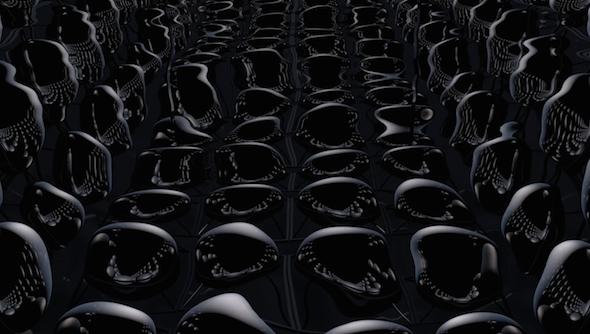Emilija Škarnulytė’s 'Mirror Matter' at Künstlerhaus Bethanien
Emilija Škarnulytė’s 'Mirror Matter' at Künstlerhaus Bethanien

Emilija Škarnulytė’s cinematic installations facilitate embodiment of non-human time scales and perceptual modes by speculatively reconstructing archeological narratives from a time that does not yet exist.
In Manifold, one of two video compilations installed in large scale at Künstlerhaus Bethanien, Škarnulytė wears a mermaid’s tail while swimming in the arctic waters of a Cold War-era submarine base. In the adjacent video projection, which incorporates a digital rendering of Super-Kamiokande neutrino observatory in Japan, water pools inside the cylindrical tube filled with mirrors, through which reflections of neutrinos are produced to achieve the speed of light.

On initial examination of images from the neutrino observatory, the artist admits that her first impulse was to inhabit this space: to swim through it, once again, with a mermaid’s tail. Though she places herself in the role of mythological species in one work, the video collages that comprise the exhibition are largely devoid of bodies – specifically, of humans. It is the use of varied visual apparatuses and views of seemingly otherworldly topographies, as well as their situation within the space, that activate a futuristic other’s vision. It is through her body, as a mediator, however, that the experience is ultimately communicated.
Indeed, the pursuit of this particular investigatory drift – of archiving post-human mythologies and the technological artifacts engaged in producing new matter – came about in large part through an experience of embodied perception during her residency in Spitsbergen. There, inside the glaciers, a fossilized palm tree forest is a prescient reminder of another geography and time beyond the grasp of human existence. As the artist describes, within this context, geological time becomes almost palpable. It is this comprehension of an alternate time scale that forms the impetus for reflecting on current society from a temporally distanced, yet physically inhabited, standpoint.

In the neutrino observatory rendered in Mirror Matter, slow panning movement gives a sense of the immensity of the nearly 13,000 photo-multipliers that inhabit this strange vessel – their ‘eyes’ engineered to watch light. Another frame depicts the Hadron Collider at CERN; its architecture envisioned through lidar scans, producing a dynamic, transparent imprint in three dimensions. Described as a vision that flows through the body, it is imagined by Škarnulytė as ‘alien archaeological vision’ with the ability to see through, and as the experience of sight farthest from the human realm. Through simultaneous perspectives, the constant surveying motion that weaves a continues thread through each video narrative, and the immersion generated by the reflective black ceiling, the viewer is imparted with this panoptical mode of perception. The shifting images are not simply seen, but felt, as they enfold the darkened cosmos, wherein direction changes, time moves differently and space fluctuates.
Within this framework – the two screens put into exchange and linked through a collaged soundscape formed of black hole emissions, gravitational waves, particle collisions and quasar recordings – the specificity of the sites depicted is not the main focal point for Škarnulytė; rather, it is communicating the scars and mythologies they are slowly materializing in the future earth’s landscape.

As a growing archive, the disparate structural and narrative fragments cohere into a kaleidoscopic entity – a living, breathing, expanding being. The visual and aural elements taken from various sources and reference points exist as separate works, but are brought together in the exhibition. And they will continue to be built upon, altered and pieced together: as though changing organisms, adapting to the environment and other life forms they come into contact with. In a process of continual formation that mirrors the geological strata she seeks to uncover and reconstruct, Škarnulytė layers and restructures her own works to produce new sensory relationships depending on the specific spaces they occupy. This tangibility through abstraction ultimately manifests an exploratory space for conceiving of how nature might meld itself with technology; how and what language would be used to communicate this new terrain; and which visual and physical systems of measurement could capture, within us, the magnitude of this warping of time and space.
***
Emilija Škarnulytė: Mirror Matter at Künstlerhaus Bethanien closes 29 October, 2017 more info